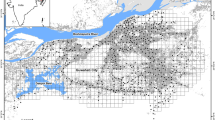Abstract
The Tree Sparrow (Passer montanus) is a dominant species in urban bird communities. With the development of urbanization, the habitats and sources of food for Tree Sparrows are decreasing. Can the urban Tree Sparrow adapt to changes in the urban environment? To answer this question, we studied the habitat use of Tree Sparrows in eight types of urban areas in Beijing. The results show that the number of both breeding and wintering Tree Sparrows decreased with increasing urbanization. The habitat use of Tree Sparrows, analyzed using stepwise discriminant analysis, was positively correlated with the number of brick bungalows, coniferous and broad-leaved trees and air conditioners. It was negatively correlated with the area of high buildings and hardened roads, pedestrian and automobile flux. This indicates that the Tree Sparrow had not adapted to rapid urbanization even though it is a generally adaptable species. Urban planning should take birds such as the Tree Sparrow into consideration.
Similar content being viewed by others
References
Blair R B (2001). Birds and butterflies along urban gradients in two ecoregions of the United States: is urbanization creating a homogenous fauna? In: Lockwood J L, McKinney M L, eds. Biotic Homogenization, New York: Kluwer Academic/Plenum Publishers, 33–56
Bolger DT (1997). Breeding bird abundance in an urbanizing landscape in coastal southern California. Conservation Biology, 11: 406–421
Chen S H, Ding P, Fan Z Y, Zheng G M (2002a). Selectivity of birds to urban woodlots. Zoological Research, 23: 31–38 (in Chinese)
Chen S H, Ding P, Zheng G M, Zhuge Y (2002b). The richness of island habitat avian communities and the influencing factors. Acta Ecologica Sinica, 22: 141–149 (in Chinese)
Chu G Z, Zheng G M (1982) A study of tree sparrows’ food in breeding period. Zoological Research, 3: 371–383 (in Chinese)
Diamond J M (1988). Urban extinction of birds. Nature, 333: 393–394
Fahrig L (2001). How much habitat is enough? Biological Conservation, 100: 65–74
Fernández-Juricic E (2004). Spatial and temporal analysis of the distribution of forest specialists in an urban-fragmented landscape (Madrid, Spain): implications for local and regional bird conservation. Landscape and Urban Planning, 69: 17–32
Fernández-Juricic E, Jokimaki J A (2001). Habitat island approach to conserving birds in urban landscapes: case studies from southern and northern Europe. Biodiversity and Conservation, 10: 2023–2043
Fletcher M R, Jones S A, Grieg-Smith P W, Hardy A R (1992). Population density and breeding success of birds. In: Grieg-Smith P, Frampton G, Hardy T, eds. Pesticides, Cereal Farming and the Environment. London: The Boxworth Project
Haire S L, Bock C E (2000) The role of landscape and habitat characteristics in limiting abundance of grassland nesting songbirds in an urban open space. Landscape and Urban Planning, 48: 65–82
Kevin R, Andrew V, Douglas T (2004) Avian assemblages along a gradient of urbanization in a highly fragmented landscape. Biological Conservation, 115: 451–462
Marzluff JM (2002). Avian ecology and conservation in an urbanizing world. Boston: Kluwer Academic Publishers
Melles S, Glenn S (2003) Urban bird diversity and landscape complexity: species and environment associations along a multiscale habitat gradient. Conservation Ecology, 7(1): 5
Meng X S, Ouyang Z Y (2004) Composition of plant species and their distribution patterns in Beijing urban ecosystem. Acta Ecologica Sinica, 24: 2200–2206 (in Chinese)
Odell E A (2001) Songbird and medium-sized communities associated with exurban development in Pitkin County, Colorlado. Conservation Biology, 15: 1143–1150
Pinowska B, Pinowski J (1999) Selected aspects of breeding biology in the tree sparrow in South Korea. Acta Zoologica Cracoviensia, 42: 435–446
Robertson K D (1983) Finches feeding on aphids in late autumn. British Birds, 76: 538
Rottenborn S C (1999) Predicting the impacts of urbanization on riparian bird communities. Biological Conservation, 88: 289–299
Ruan X, Zheng G (1991). Breeding ecology of the tree sparrow (Passer montanus) in Beijing. In:Pinowsdi J, Kavanagh B, Gorski W, eds. Nestling Mortality of Granivorous Birds due to Microorganisms and Toxic Substances. Warsaw: PWN, 99–109
Tilghman N G (1987). Characteristics of urban woodlands affecting breeding bird diversity and abundance. Landscape and Urban Planning, 14: 481–495
Torok J (1990). The impact of insecticides on the feeding of the tree sparrows (Passer montanus) in orchards during the parental care period. In: Pinowski J, Summers-Smith J D, eds. Granivorous Birds in the Agricultural Landscape, Warsaw: PWN, 199–210
Author information
Authors and Affiliations
Corresponding author
Additional information
__________
Translated from Biodiversity Science, 2006, 14(5): 372–381 [译自:生物多样性]
Rights and permissions
About this article
Cite this article
Zhang, S., Zheng, G. & Xu, J. Habitat use of urban Tree Sparrows in the process of urbanization: Beijing as a case study. Front. Biol. China 3, 308–314 (2008). https://doi.org/10.1007/s11515-008-0042-x
Published:
Issue Date:
DOI: https://doi.org/10.1007/s11515-008-0042-x




